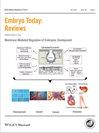Rama Rao Damerla, George C. Gabriel, You Li, Nikolai T. Klena, Xiaoqin Liu, Yu Chen, Cheng Cui, Gregory J. Pazour, Cecilia W. Lo
下载PDF
{"title":"纤毛在结构性出生缺陷中的作用:来自纤毛病突变小鼠模型的见解","authors":"Rama Rao Damerla, George C. Gabriel, You Li, Nikolai T. Klena, Xiaoqin Liu, Yu Chen, Cheng Cui, Gregory J. Pazour, Cecilia W. Lo","doi":"10.1002/bdrc.21067","DOIUrl":null,"url":null,"abstract":"<p>Structural birth defect (SBD) is a major cause of morbidity and mortality in the newborn period. Although the etiology of SBD is diverse, a wide spectrum of SBD associated with ciliopathies points to the cilium as having a central role in the pathogenesis of SBDs. Ciliopathies are human diseases arising from disruption of cilia structure and/or function. They are associated with developmental anomalies in one or more organ systems and can involve defects in motile cilia, such as those in the airway epithelia or from defects in nonmotile (primary cilia) that have sensory and cell signaling function. Availability of low cost next generation sequencing has allowed for explosion of new knowledge in genetic etiology of ciliopathies. This has led to the appreciation that many genes are shared in common between otherwise clinically distinct ciliopathies. Further insights into the relevance of the cilium in SBD has come from recovery of pathogenic mutations in cilia-related genes from many large-scale mouse forward genetic screens with differing developmental phenotyping focus. Our mouse mutagenesis screen for congenital heart disease (CHD) using noninvasive fetal echocardiography has yielded a marked enrichment for pathogenic mutations in genes required for motile or primary cilia function. These novel mutant mouse models will be invaluable for modeling human ciliopathies and further interrogating the role of the cilium in the pathogenesis of SBD and CHD. Overall, these findings suggest a central role for the cilium in the pathogenesis of a wide spectrum of developmental anomalies associated with CHD and SBDs. <b>Birth Defects Research (Part C) 102:115–125, 2014.</b> © <b>2014 Wiley Periodicals, Inc.</b></p>","PeriodicalId":55352,"journal":{"name":"Birth Defects Research Part C-Embryo Today-Reviews","volume":"102 2","pages":"115-125"},"PeriodicalIF":0.0000,"publicationDate":"2014-06-26","publicationTypes":"Journal Article","fieldsOfStudy":null,"isOpenAccess":false,"openAccessPdf":"https://sci-hub-pdf.com/10.1002/bdrc.21067","citationCount":"22","resultStr":"{\"title\":\"Role of cilia in structural birth defects: Insights from ciliopathy mutant mouse models\",\"authors\":\"Rama Rao Damerla, George C. Gabriel, You Li, Nikolai T. Klena, Xiaoqin Liu, Yu Chen, Cheng Cui, Gregory J. Pazour, Cecilia W. Lo\",\"doi\":\"10.1002/bdrc.21067\",\"DOIUrl\":null,\"url\":null,\"abstract\":\"<p>Structural birth defect (SBD) is a major cause of morbidity and mortality in the newborn period. Although the etiology of SBD is diverse, a wide spectrum of SBD associated with ciliopathies points to the cilium as having a central role in the pathogenesis of SBDs. Ciliopathies are human diseases arising from disruption of cilia structure and/or function. They are associated with developmental anomalies in one or more organ systems and can involve defects in motile cilia, such as those in the airway epithelia or from defects in nonmotile (primary cilia) that have sensory and cell signaling function. Availability of low cost next generation sequencing has allowed for explosion of new knowledge in genetic etiology of ciliopathies. This has led to the appreciation that many genes are shared in common between otherwise clinically distinct ciliopathies. Further insights into the relevance of the cilium in SBD has come from recovery of pathogenic mutations in cilia-related genes from many large-scale mouse forward genetic screens with differing developmental phenotyping focus. Our mouse mutagenesis screen for congenital heart disease (CHD) using noninvasive fetal echocardiography has yielded a marked enrichment for pathogenic mutations in genes required for motile or primary cilia function. These novel mutant mouse models will be invaluable for modeling human ciliopathies and further interrogating the role of the cilium in the pathogenesis of SBD and CHD. Overall, these findings suggest a central role for the cilium in the pathogenesis of a wide spectrum of developmental anomalies associated with CHD and SBDs. <b>Birth Defects Research (Part C) 102:115–125, 2014.</b> © <b>2014 Wiley Periodicals, Inc.</b></p>\",\"PeriodicalId\":55352,\"journal\":{\"name\":\"Birth Defects Research Part C-Embryo Today-Reviews\",\"volume\":\"102 2\",\"pages\":\"115-125\"},\"PeriodicalIF\":0.0000,\"publicationDate\":\"2014-06-26\",\"publicationTypes\":\"Journal Article\",\"fieldsOfStudy\":null,\"isOpenAccess\":false,\"openAccessPdf\":\"https://sci-hub-pdf.com/10.1002/bdrc.21067\",\"citationCount\":\"22\",\"resultStr\":null,\"platform\":\"Semanticscholar\",\"paperid\":null,\"PeriodicalName\":\"Birth Defects Research Part C-Embryo Today-Reviews\",\"FirstCategoryId\":\"1085\",\"ListUrlMain\":\"https://onlinelibrary.wiley.com/doi/10.1002/bdrc.21067\",\"RegionNum\":0,\"RegionCategory\":null,\"ArticlePicture\":[],\"TitleCN\":null,\"AbstractTextCN\":null,\"PMCID\":null,\"EPubDate\":\"\",\"PubModel\":\"\",\"JCR\":\"Q\",\"JCRName\":\"Medicine\",\"Score\":null,\"Total\":0}","platform":"Semanticscholar","paperid":null,"PeriodicalName":"Birth Defects Research Part C-Embryo Today-Reviews","FirstCategoryId":"1085","ListUrlMain":"https://onlinelibrary.wiley.com/doi/10.1002/bdrc.21067","RegionNum":0,"RegionCategory":null,"ArticlePicture":[],"TitleCN":null,"AbstractTextCN":null,"PMCID":null,"EPubDate":"","PubModel":"","JCR":"Q","JCRName":"Medicine","Score":null,"Total":0}
引用次数: 22
引用
批量引用

 求助内容:
求助内容: 应助结果提醒方式:
应助结果提醒方式:


